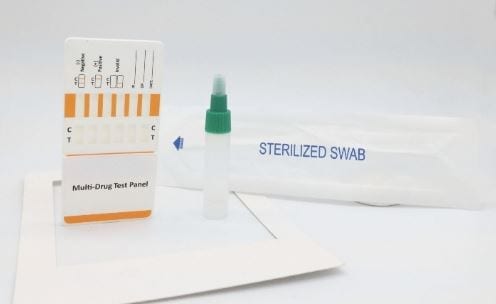Multi-drug test for powders and brushing samples
23,90 €
A reliable and easy-to-use multi-drug sieve used by professionals detects 11 different drugs.
- Accuracy 98% compared to laboratory tests.
- CE marked
- Result in five minutes.
- Fast and anonymous mail delivery
- Optionally for a fee to package automat or post office
Availability: In stock
This multi-drug test is suitable for the demonstration of drugs and drugs from powders and surface samples, as well as urine and drink samples. The test tests drugs and their residues, so the target of the test may be a full or empty powder bag found on the premises of a workplace or school, a vague substance found at a house party, a table surface or, for example, a single pill found on the floor. Even very small residues are identified
The test is a panel consisting of 11 drug strips and contains a buffer solution for dissolving a powdered and/or dry sample.
The drug groups to be tested and the sensitivity limits ng/ml are:
- amphetamine (AMP1000)
- ecstasy (MDMA500)
- methamphetamine (MET1000)
- cannabis (THC50)
- cocaine (COC300)
- morphine derivatives (MOP300)
- LSD (LSD20)
- benzodiasepirins (BZO300)
- buprenorphine (BUP10)
- methades (MTD300)
- tramadol (TML100).
To perform a drug test:


Take a test of powder
- Open the drug sieve bag and remove the plug that protects the ends of the test screens.
- When testing brushable surfaces, wipe the surface to be tested at the ends of the strips (table, plane, floor, etc.) by crossing the tick on both sides at the gentlest possible angle so that the exposed strip heads touch the surface to be examined almost in length.
- When testing a powdered sample, open the green screw cap on the bumper tube and add the solid powder to the buffer tube. Close the tube again with a green screw cap (where the drip cap is closed), shake vigorously for a moment, then wait 30 seconds.
- Then open the colourless drip cap of the bumper tube and drain, squeezing the tube, the entire contents of the tube into the plug that protected the test irons.
- Carefully and slowly push the drug screen (so that the buffer does not splash out of the stopper) back into the protective cap until the stopper is at its original depth to protect the strip heads.
- Monitor the progression of the colored solution front and wait until a clear C zone has appeared on all strips. Read the result 5 minutes after closing the stopper (no longer after more than 10 minutes) and interpret the result for each strip separately as follows:
When two lines (C and T) are displayed inthe test window, the result is NEGATIVE, i.e. there are no signs of substances belonging to that drug group in the brush or powder sample.
When only the C line is displayed in the test window (i.e. the T-lineis missing), the result is POSITIVE, i.e. the sample examined contains compounds belonging to the drug group in question.
If the test window contains only a T-line or no lines (that is, whenever the C line is missing), test has been failed. Run a new test with a new test. If the coloured solution front did not appear at all, the buffer is not absorbed from the stopper into the strips. In this case, you can attempt to start the absorption by knocking on the tester and placing it horizontally (as long as the plug does not leak). If the solution front progressed through the test window up and the background beed, but zone C did not appear, contact the importer.
| Weight | 0,02 kg |
|---|---|
| Dimensions | 15 × 5 × 2 cm |
Only logged in customers who have purchased this product may leave a review.






Reviews
There are no reviews yet.